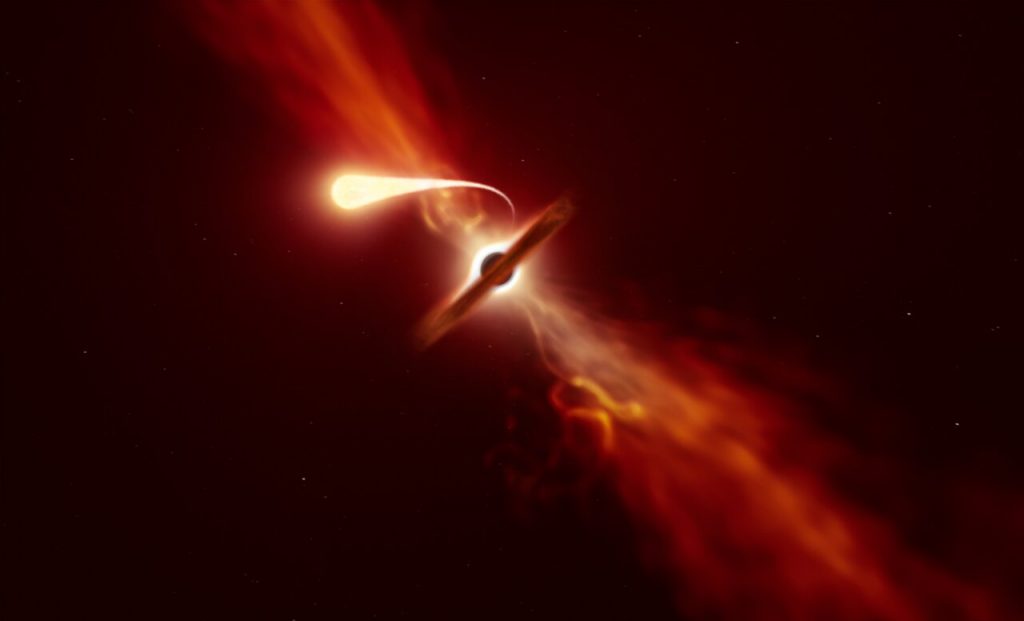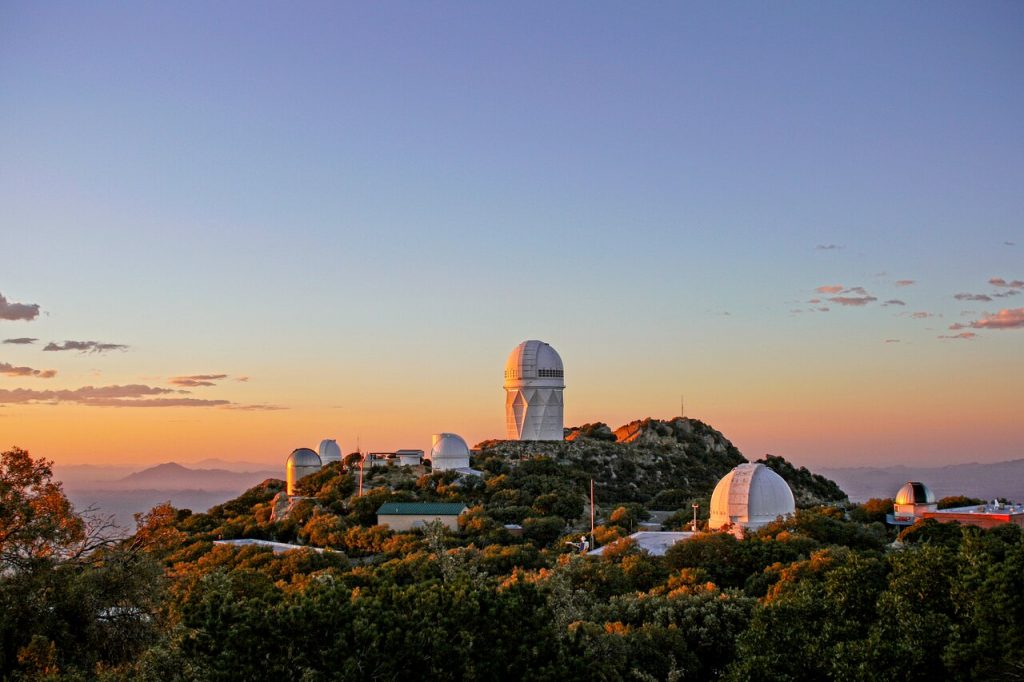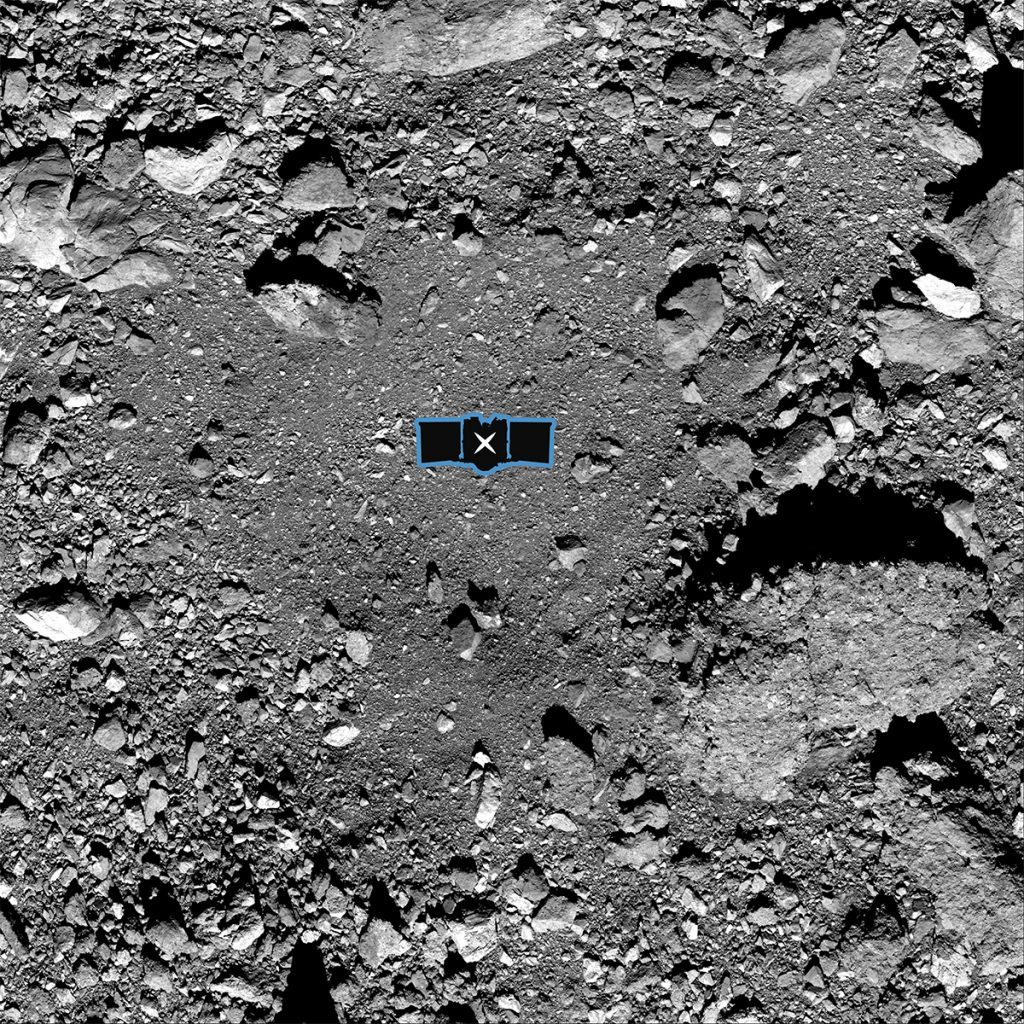Media
Transcript
There are certain words that are simply pleasing. They are a combination of sounds and mouth movements that just feel good. Arugula. I, for one, am fond of the word arugula even if I’m not entirely fond of eating arugula. Another such pleasing word is spaghettification. As its syllables are bounced back and forth along the speech palette, the word describes the end of stars, planets, asteroids, and maybe even people.
This word, spaghettification, describes how the differences in the pull of gravity between the near and far side of an object can cause that object to be torn apart – tidally disrupted if you want the science term – and then those disrupted pieces can get strung out as they fall toward the disrupting body, breaking up further as each piece is stretched and pulled apart until all that is left is the long tail of debris spiraling in toward its doom.
If you’re into cosmic death, spaghettification is a fascinating way to go. The human body, stretched under the pull of gravity into a string of atoms, would create a spiral that if laid straight would stretch 70 some odd light-years across the universe.
But mostly, spaghettification is just theoretical. Most of the time, the dusty and cluttered area around black holes obscures the flares and flashes of light that can be associated with objects being torn about.

But most of the time is not all of the time, and in an amazing case of luck and pre-planning, an international team of astronomers has been able to observe the slow demise of a star being tidally disrupted as it fell into a supermassive black hole.
Last September, a variety of all-sky surveys alerted astronomers to an increase in brightness in the center of the barred spiral 2MASX J04463790-1013349. Viewed from straight above this system, astronomers were able to catch an unimpeded view of what is believed to be a star being shredded.
Once the initial uptick in light was spotted, many of the world’s largest telescopes pointed at the system to see what was going on. The rise in brightness didn’t match a supernova, and it was located in the center of the galaxy rather than in a more traditional star-forming region or outer area where a supernova might normally be found. Instead, it matched the behavior of a star being spaghettified. According to the lead author of a new paper appearing in Monthly Notices of the Royal Astronomical Society (MNRAS): The idea of a black hole ‘sucking in’ a nearby star sounds like science fiction. But this is exactly what happens in a tidal disruption event.
According to the press release: To get a detailed look at just what happens when a star is devoured by a monstrous black hole, researchers pointed the European Southern Observatory’sVery Large Telescope (VLT) and New Technology Telescope (NTT) at a new flash of light that occurred close to a supermassive black hole last year. Follow-up observations occurred over a six-month period at multiple telescopes around the world, including the Center for Astrophysics | Harvard & Smithsonian’sMMT, located at the Fred Lawrence Whipple Observatory in Amado, Arizona.
This is the closest spaghettified star to so far be detected, and early detection by all-sky surveys allowed it to be studied before the star’s material could coalesce into dust and debris.
Co-author Kate Alexander explains: Because we caught it early, we could actually see the curtain of dust and debris being drawn up as the black hole launched a powerful outflow of material with velocities up to 10,000 km/s. This is a unique ‘peek behind the curtain’ that provided the first opportunity to pinpoint the origin of the obscuring material and follow in real-time how it engulfs the black hole.
The observations themselves aren’t entirely satisfying; the system got brighter and fainter. The coolest science will come later when detailed models explaining the star’s final days can be published. This is our reminder that observers catch only hints of what is happening, and it is through computer models that match those observations that we tease out the details.
These observations, from prior to the March 2020 COVID shut down, also remind us how important it is to have regular access to the sky through a myriad of different telescopes.
For the past many months, our observing abilities have been limited, with the closure of numerous observatories in Chili and Arizona. Construction was also stopped at the Vera Rubin Observatory, the home of the LSST. Due to the limited impact of COVID on the Big Island of Hawaii, Maunakea Observatories has stayed open for limited science and has been a proving ground for safety protocols and implementation of protective measures. Now, the lessons learned are being implemented elsewhere.

Construction of LSST has resumed and Kitt Peak National Observatory is doing the maintenance and preparatory activities needed to open by mid-November. Cerro Tololo Inter-American Observatory (CTIO) resumed activities October 11 with the four-meter Victor Blanco Telescope, and other facilities should be resuming activities in early November. SOAR has been doing engineering tests, and Gemini South is doing maintenance with the intention to resume science later in October.
While we’re still seeing a steady stream of research, the stream isn’t what it used to be, and we can expect it to continue to slowly dwindle as the research is impacted more and more by lack of telescope access, lab access, and the overall difficulty of getting work done with normal efficiency in these inexplicable times. Science goes slowly, with six months to two years often passing between observations being taken and journal articles being accepted and published. While predictions are that COVID will continue to impact the US through at least the fall of 2021, we can expect to see science impacted through 2023 or beyond.
And no, I have no idea how the launch date of the JWST will continue to evolve. If I were a betting person, I’d say 2022 at the earliest and most likely 2024.
Luckily, we still have some missions out there keeping some of us more than a little bit busy.
Here at CosmoQuest – home of the Daily Space – our citizen scientists were part of mapping the asteroid Bennu to find a suitable site for the OSIRIS-REx mission to grab a rock sample to bring to Earth. We are now one week away from this sampling event! We will be simulcasting any NASA live streams here on CosmoQuestX on Twitch.tv.

According to a suite of journal articles that came out last week, Bennu is considered to be a rubble pile asteroid with material from multiple objects – including a few pieces knocked off Vesta – that are gravitationally held together. According to project scientist Vicki Hamilton: Our recent studies show that organics and minerals associated with the presence of water are scattered broadly around Bennu’s surface, so any sample returned to Earth should contain these compounds and minerals. We will compare the sample’s relative abundances of organics, carbonates, silicates, and other minerals to those in meteorites to help determine the scenarios that best explain Bennu’s surface composition.
Put another way, they are hoping that the few grams of material they’re able to pick up will allow us to work backward to figure out the mineral recipe that makes up Bennu. It appears to be a mixture of rocks that formed in dry and wet environments, but the ratios and details still need reverse engineered.
And next week, the needed material will get picked out of Nightingale Crater to be flown home next year. This mission is following in the path of Hayabusa2, which collected samples from asteroid Ryugu that will be returned to Earth on December 6 of this year.
When that happens, we’ll bring you the science.
Learn More
Star Dies by Black Hole Spaghettification
- ESO press release
- CFA press release
- “An Outflow Powers the Optical Rise of the Nearby, Fast-Evolving Tidal Disruption Event AT 2019qiz,” M. Nicholl et al., 2020 Oct. 12, Monthly Notices of the Royal Astronomical Society (preprint on arxiv.org)
Restart of Operations at Kitt Peak, Cerro Pachon & Cerro Tololo
Scientists Study Rugged Surface of Near-Earth Asteroid Bennu
- Southwest Research Institute press release
- “Variations in Color and Reflectance on the Surface of Asteroid (101955) Bennu,” D. N. DellaGiustina et al., 2020 Oct. 8, Science
- “Bright Carbonate Veins on Asteroid (101955) Bennu: Implications for Aqueous Alteration History,” H. H. Kaplan et al., 2020 Oct. 8, Science
- “Widespread Distribution of Carbon-Bearing Materials on Near-Earth Asteroid (101955) Bennu,” Amy Simon et al., 2020 Oct. 8, Science
Credits
Written by Pamela Gay
Hosted by Pamela Gay
Audio and Video Editing by Ally Pelphrey
Content Editing by Beth Johnson
Intro and Outro music by Kevin MacLeod, https://incompetech.com/music/


 We record most shows live, on Twitch. Follow us today to get alerts when we go live.
We record most shows live, on Twitch. Follow us today to get alerts when we go live.